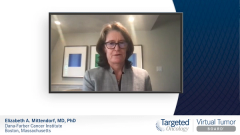
Case 3: Practical Considerations for Use of Sacituzumab Govitecan
Ruta Rao, MD, discusses practical considerations regarding the use of sacituzumab govitecan in patients with relapsed/refractory TNBC.
Episodes in this series

Elizabeth A. Mittendorf, MD, PhD: I want to go back to something you said. As we’re all aware, sacituzumab govitecan was conditionally approved. It was just formally approved by the FDA, and it’s approved for third line. You mentioned that this is a patient you’d want to give it to in the second-line setting because we want this tumor board that we’re conducting to be practical. What issues, if any, have you had with getting it approved in the second line?
Ruta Rao, MD: I actually had 1 patient for whom they would not approve it in the second line because she had not had 2 prior lines of treatment in the metastatic setting. As we look at a patient history, similar to the 1 we’re discussing, we could all agree that this patient has had a lot of prior chemotherapy: anthracycline, Cytoxan, taxane, as well as capecitabine.
Elizabeth A. Mittendorf, MD, PhD: And carboplatin-gemcitabine. She got carboplatin-gemcitabine.
Ruta Rao, MD: So she got 2 more drugs as her first-line chemotherapy. In the study, it was all patients who had already had second line. This was their third line or more. We just have to be a little conscious of that. We should think about that when we’re prescribing it or thinking about prescribing it.
David G. Hicks, MD: I have a question for Ruta. Does the BRCA status influence what chemotherapies you’re likely to recommend?
Ruta Rao, MD: That’s a great question. We all accept that the BRCA-mutant patients and probably even the PALB2-mutation carriers because they’re along the same pathway and are more sensitive to platinum agents. If we’re going to use chemotherapies, we will use platinums. As Beth said before, we could have a whole other session on adjuvant therapy or neoadjuvant therapy and using platinums—especially in the neoadjuvant setting—for these triple-negative breast cancers. But a BRCA-carrier patient will probably receive a platinum as 1 of her first lines of treatment.
Elizabeth A. Mittendorf, MD, PhD: Of the agents we’ve discussed—immunotherapy, PARP inhibitors, and sacituzumab—sacituzumab is the most recent. Ruta, maybe you could share your experience giving this drug with respect to patient tolerability, adverse effects, and so on.
Ruta Rao, MD: For the most part, in my experience, it has been well tolerated. The trials showed that the most significant adverse effects seen were neutropenia, diarrhea, anemia, and febrile neutropenia. They did not see any grade 3 or greater neuropathy or interstitial lung disease. That’s important, because a lot of these patients have come pretreated with chemotherapy drugs that cause neuropathy. It’s nice to have something that does not seem to worsen the neuropathy. In terms of the neutropenia, as medical oncologists, we’re very familiar with using growth factors. I’ve had to modify the regimens to use growth factors after day 1, often after day 8, so that the patient is not neutropenic and can stay on time with their second and subsequent cycles of sacituzumab.
Elizabeth A. Mittendorf, MD, PhD: It seems well tolerated. Obviously, those ASCENT data were quite impressive, clearly leading to an approval with a phase 2 study. Having said that, just as I said before with the other people who are responding to immunotherapy, there are people responding to the sacituzumab who then progress. What’s the next line? What are you doing with your patients? Let’s say this poor young woman had an initial response to sacituzumab and then progressed. What would you think then?
Ruta Rao, MD: For those patients, you’re hoping you can find a clinical trial because, as you can even see from the ASCENT data, the PFS [progression-free survival] overall survival and response rates for subsequent chemotherapies in these settings are low. We want to give our patients more hope than that. I hope most medical oncologists at that time are looking for a clinical trial that the patient may be appropriate for.
Elizabeth A. Mittendorf, MD, PhD: I love that answer. I’ve been in this business long enough that when I started in my practice, I would suggest that there’s no standard for metastatic triple-negative breast cancer. At the time, the standard was to encourage clinical trial participation. Tonight we’ve talked about how there’s immunotherapy, there are PARP inhibitors, and there is sacituzumab. I love that after sacituzumab you’re thinking about clinical trials, but how do you think about trials earlier? Now you have these 3, which all have available data and then go to trials. This might be a bit of a simplification, but we would think that most agents are going to be more effective in an earlier line of therapy. If you’re doing a trial in patients who are in their fourth and fifth lines of therapy, it stacks the deck against the experimental agent when compared with evaluating that same agent in an earlier-line setting. As a medical oncologist, how do you think about these things?
Ruta Rao, MD: That’s absolutely right. We should think about clinical trials in all lines, even first line. As we do at our institution, and I’m sure at yours, we first think about which trials we have opened in that space and whether the patient is a candidate for that. If not, then we fall back to our first-line immunotherapy plus chemotherapy—in a PD-L1–positive patient followed by X, Y, and Z. But yes, you’re right: The clinical trials should always be our first go-to for these patients.
Elizabeth A. Mittendorf, MD, PhD: Sticking with sacituzumab, there are great data in the metastatic setting. What are you aware of, with respect to looking at this agent, in earlier-stage disease?
Ruta Rao, MD: With all our breast cancer therapies, if something is shown to be effective in later lines of therapy, we always want to pull it forward. Off the top of my head, I’m not sure which clinical trials are open, but the next steps are to look at this in the adjuvant and residual disease settings.
Elizabeth A. Mittendorf, MD, PhD: Sacituzumab is the hot drug, so there’s a lot of conversation about it. We have 2 ongoing trials at our institution, Dana-Farber Cancer Institute, looking at sacituzumab plus immunotherapy in a metastatic setting. Not the question I asked you, but another sacituzumab trial. David, you mentioned earlier that there was some solid rationale for putting a PARP with an immunotherapy. There’s some rationale for adding sacituzumab to immunotherapy. Some suggest that sacituzumab might activate the sting pathway, to David’s point. It’s that spark plug to get an immune response going. There’s also a trial that’s about to be initiated through our system looking at it in the neoadjuvant setting. To your point, Ruta, I have a trial that’s under review that I’m proposing with my colleague Brian Delaney that looks at the use and the adjuvant setting of ctDNA [circulating tumor DNA] for patients after chemotherapy. If they’re ctDNA-positive, that’s a marker of residual disease to look at sacituzumab. There’s a lot of interest in the space.
Going back to something we talked about earlier, I liked the way we’ve thought through this patient: no mutations and no PARP, give her immunotherapy, and now we give her sacituzumab. When you start doing sequencing of your patients to look for an actionable mutation, I presume you might consider it to inform that trial if she would have progressed on sacituzumab. But would you have thought about doing that earlier for this patient with metastatic triple-negative breast cancer?
Ruta Rao, MD: Probably at the time you did a biopsy of the liver lesions or the mediastinal adenopathy and confirmed her to be triple-negative and PD-L1 positive. At that point, we would consider sending for next-generation sequencing.
Transcript edited for clarity.











































